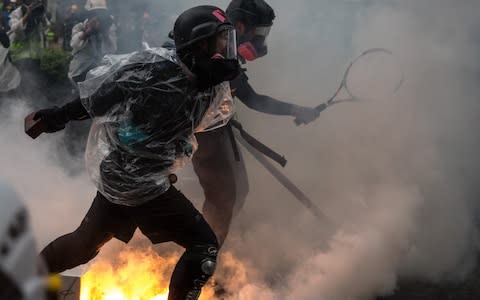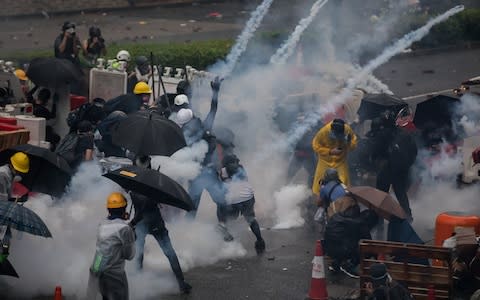Hong Kong police officer 'fires warning shot' amid fresh clashes with protesters

At least one Hong Kong police officer fired a warning shot during clashes with protesters armed with sticks on Sunday, the first time a live round has been used in three months of protests.
The incident occurred as riot police also deployed water cannon trucks for the first time since mass demonstrations began, shooting volleys of tear gas and rubber bullets at protesters chucking bricks and homemade petrol bombs, shrouding the mostly residential neighbourhood of Tsuen Wan in chaos.
Several officers, not equipped with riot gear, drew their pistols after a group of protesters attacked a police van, forcing those inside to exit the vehicle.
At least one officer fired his weapon after another fell to the ground as protesters charged. Earlier, protesters scattered after water cannon and tear gas were deployed, some taking shelter in a nearby mall and barricading themselves in, while others headed for neighbourhoods several miles away, sparking off more clashes through the night.

Hong Kong police said on Monday they arrested 36 people, the youngest aged 12.
Sunday’s standoffs closed a weekend of violent skirmishes that ended nearly two weeks of relative calm in the glittering financial hub.
The day's descent into violence followed what is now a familiar cycle of weekend events for the seven million people in Hong Kong.
Thousands had turned out earlier in the day for a peaceful march, defying sheets of rain, before a group of radical protesters began building barricades with street rails, metal rubbish bins and bamboo poles.
Riot police in full gear soon arrived at the scene to clear the roads. They ordered protesters to disperse before firing tear gas and making arrests.
The police said 15 officers were injured and insisted that the force used was appropriate. “Our officers’ lives were certainly in great danger,” said senior superintendent Yolanda Yu at a late night press briefing.

“The escalating illegal and violent acts of radical protesters are not only outrageous, they also push Hong Kong to the verge of a very dangerous situation,” the police said in a statement.
Police have arrested more than 700 people – some as young as 13 – since mass protests kicked off in early June when crowds took to the streets against a proposed changes to Hong Kong's extradition laws.
The now-suspended bill would have sent people to face trial in mainland China, where Communist Party control of the courts leads to a 99.9 percent conviction rate.
Although the bill has been shelved, protesters continue to demand it be formally withdrawn, fearing that authorities could otherwise table it again and quickly pass once the protests end.

Since the protests began, their demands have also expanded to include an independent investigation of police actions, the resignation of Hong Kong chief executive Carrie Lam, and direct leadership elections.
Hong Kong's leadership, however, has offered no concessions, and its apparent decision to instead rely on the police to quell unrest has caused increasing ire among demonstrators.
Earlier on Sunday, a few hundred people who said they were relatives of Hong Kong police officers attended a rally to criticise the government for failing to solve what they see as a political problem, not a law enforcement issue.
“For these three months, the government has been hiding – they put the burden on police,” said Ms Lee, 34, who declined to give her full name and said her brother-in-law was a police officer.
Hundreds of officers have also had their personal details posted online, an act known as “doxxing,” as anger grows against the police.
“The reason why there is ‘doxxing’ is because the government still hasn’t done anything. They should be responsible for what’s happening,” said Ms Lee.
But “because the government doesn’t solve the problem, more people will be affected, including the family of police.” Fallout from the protests have also hit major Hong Kong corporations.
MTR – a publicly-traded firm majority-owned by the government which runs the city's subway system – obtained on Friday an interim injunction order to prevent people from obstructing normal train operations.
The move was seen as response to criticism in the Chinese state media that it was “colluding with rioters” after arranging extra trains to take protesters home.
Several train stations along the planned march routes were closed over the weekend, stranding residents accustomed to the city’s normally very reliable public transport.
Meanwhile, Cathay Pacific has been rocked by a series of staff changes over the past week, including the surprise resignation of its CEO, a move that was widely seen as an attempt to curry political favour with Beijing after the Hong Kong airline was blasted when a pilot was arrested at a protest.
“I think politics is involved,” said Fox Cheung, 30, who had to detour an extra 20 minutes to hop on a train home after work. As a train operator, “obviously MTR could do better, but I think they are under great pressure, just like Cathay Pacific.”

